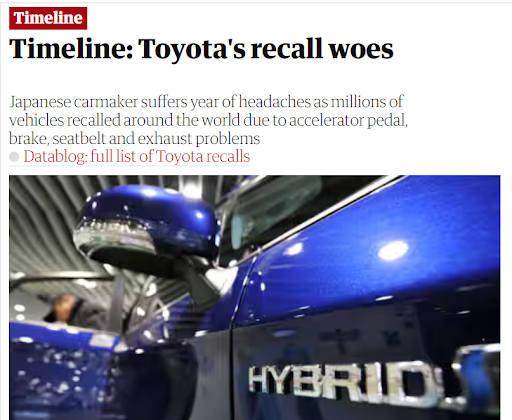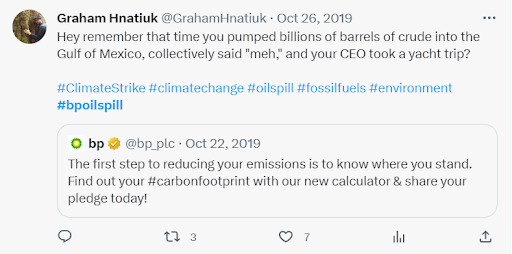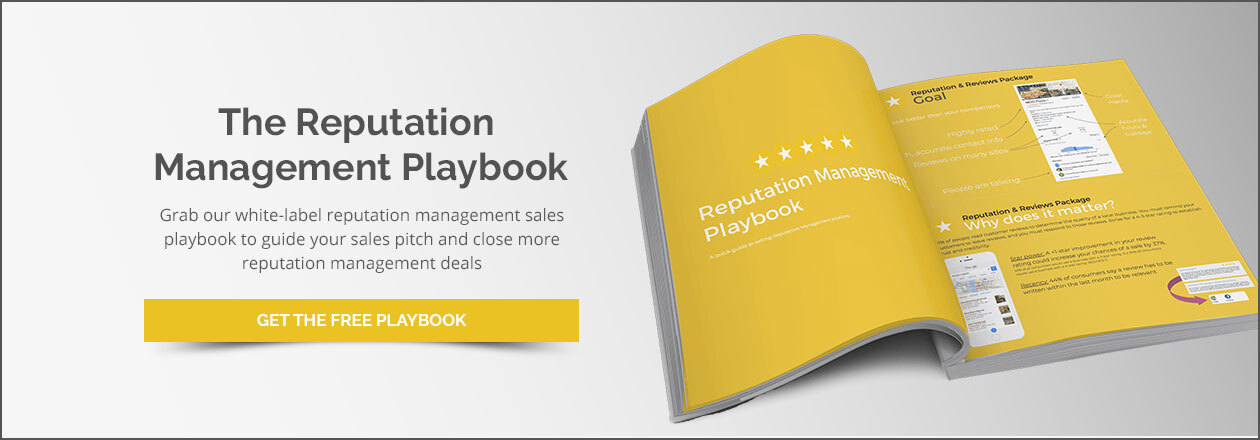Here’s everything you need to know about reputation risk
Key insights
- Reputational risk refers to the potential damage to a business's reputation, which can be difficult to bounce back from.
- Businesses can mitigate reputational risk by identifying potential hazards and taking steps to address them.
- Reputation risk management tactics can include monitoring social media for red flags, responding to negative comments or reviews, and bolstering a positive online reputation.
Review sites, social media platforms, and the internet have given consumers the power to influence public opinion like never before, and with that, avoiding reputational risks has become a big-ticket item for businesses of every shape and size. A single negative comment or review can quickly go viral, leading to a widespread negative perception of a brand. This is why it is important to be proactive in managing risks, by identifying potential hazards and taking steps to mitigate them.
Find out how to capitalize on a good review and minimize the damage of a bad one. Download these review response templates now.
In this guide, we will explore the concept of reputational risk, including why reputation is important, common risks your clients are likely to face, and ways to mitigate a tarnished image. That way, you can help your SMBs (small business clients) avoid these potential pitfalls before they can snowball.
What is reputation risk?
Reputation risk refers to the risk of potential damage to a business’s public image. It’s a risk that can arise from a variety of factors and is often unpredictable. It also can have a significant impact on a company's revenue, as it can lead to a loss of customers and a damaged reputation that can be difficult to repair.
Reputation risk can come from numerous sources, such as poor customer service, product recalls, data breaches, or even fake Google reviews.
To manage a reputation, an ounce of prevention is worth a pound of cure. Take a proactive approach by monitoring their online presence, helping them engage with customers, and responding quickly to negative feedback or reviews. They can also establish crisis management plans and protocols to address reputational risks as they arise.
Related posts: How to Monitor Online Reputation for Your Clients
Why is identifying reputational risk important?
Your client’s reputation is one of their most valuable assets. It takes a long time to build a positive reputation, but only a moment for it to come crashing down. The worst part is that these risks can occur with little to no warning. That’s why it's critical to be prepared and watch out for potential dangers along the horizon.
Managing reputational risk helps your clients protect themselves from potential harm, maintain customer trust, and enhance their overall business performance and profitability.
Related posts:
Importance of Reputation Management & Mistakes
Reviewing Monitoring Tools and Guide
Why are Google reviews not showing up? How to solve in 2023
Reputational risk examples
Reputational risk can come from factors found both inside and outside the business, so SMBs must be proactive in managing potential shortfalls to avoid their negative consequences.
By identifying potential risks and taking steps to mitigate them early, any business can better protect its reputation. Failure to do so, however, could lead to the famous examples found below:
Cybersecurity breach example
When your business is trusted with sensitive information, you must do everything in your power to protect it. But what happens when you don’t? Cybersecurity breaches can result in the loss of sensitive customer information, financial data, and trade secrets. These incidents can lead to a loss of trust in the company and damage its reputation. For example, the 2017 Equifax data breach led to a significant drop in the company's stock price, and even years six later, users are still feeling the effects.
(source: X)
Product recalls
Product recalls can be damaging not only to a company's reputation but also its bottom line. Fixing or replacing defective products and honoring refunds be costly, and still may not fully guarantee earning back consumer trust. For example, the 2010 Toyota recall saw millions of vehicles pulled from owners and dealerships due to a faulty accelerator pedal. This led to a significant loss of trust in the company and a decline in sales for years following a string of later recalls. (The Guardian)
(source: The Guardian)
Environmental incidents
Environmental incidents due to neglect, such as oil spills or chemical leaks, can have a significant impact on a company. These incidents can lead to negative media coverage and public outcry from citizens and environmental groups alike. For example, the 2010 BP oil spill in the Gulf of Mexico saw 4 million barrels of oil seep into the gulf over 87 days. (United States Environmental Protection Agency)
While the incident is over a decade old, users on X (formerly Twitter) were still voicing their frustrations nine years later.
(source: X)
Social media storms
Social media frenzies caused by a customer voicing their opinion online can quickly go viral and damage the public perception of a business. For example, the 2017 United Airlines incident, where a passenger was forcibly removed from a flight, led to a sharp decline in the company's reputation and many users voiced publicly that they’ll be taking their business elsewhere.
(source: Youtube)
Related posts: 8 Best Examples of Reputation Management
7 common types of reputational risk to avoid
Risks to a business’s reputation can come in many shapes and forms. Below are some common risks to be on the watch for:
1. Product and service issues
If a business's product or service fails to meet customer expectations due to deceptive marketing or causes harm, it can damage the business's reputation, and may even lead to legal action.
2. Data breaches and cyber attacks
With our increasing reliance on technology, data breaches, and cyber attacks can be a major reputational risk. Customers may lose trust in a business that fails to protect their personal information from hackers.
3. Employee misconduct
Fraud, harassment, or discrimination, can reflect poorly on a business. Companies need to have strong policies and procedures in place to prevent and address such behavior.
4. Leadership and management issues
Poor leadership or mismanagement can lead to significant reputational damage if left to go unchecked. For example, a CEO who engages in unethical behavior or a company that fails to address employee concerns can lead to whistleblowers, worker protests, and bad press. Customers actively avoid doing business with companies that behave in a way they do not agree with.
5. Legal and regulatory issues
Navigating legal and regulatory issues with care is important, as any violations can severely damage your client’s hard-earned reputation. Whether accidental or intentional, breaches of laws and regulations not only result in financial penalties but also erode trust among customers, partners, and stakeholders.
6. Social media and public opinion
Social media can amplify negative opinions and quickly spread damaging information. For example, this post from a user in 2021 highlights the fact Burger King made a sexist post on X during one of its marketing campaigns. Companies need to be careful of the messaging they are using and have a plan in place to effectively respond to negative feedback left about them online.
(source: X)
7. Competition and industry issues
Competition and industry issues are also something an SMB should consider. For example, a company that is seen as lagging behind its competitors or finds itself associated with a controversial industry may suffer reputational damage.
By understanding the most common types of reputational risk, SMBs can take steps to mitigate their impact and protect their reputation.
Related posts: 8 Types of Reputation Management
Factors that can increase reputational risk
In this section, we’ll delve into the factors that have the most potential to harm an SMB’s image. Identifying what can tarnish a reputation can help you spot any gaps that need filling.
Direct actions of the business
This can include anything ranging from noncompliance with regulations to fraudulent activities and problematic business practices. An example would be something like buying Google reviews to artificially inflate your star ranking. Whether intentional or unintentional, a client looking to grow should review their practices and supply chain for anything that could be seen as unsavory by the public.
Employee actions
Another factor to consider is the actions of your SMB’s team. For instance, if an employee engages in unethical behavior or makes inappropriate comments on social media, it can negatively impact your client’s reputation. Therefore, it is crucial to provide proper training to your employees and ensure that best practices are in place to mitigate this risk.
Negative reviews
While a larger company might be able to absorb a few blows to the ego, negative reviews can make or break a small business. Review bombing, where numerous negative reviews are posted in a short period of time on platforms such as Google, can be particularly harmful. Therefore, it is essential to manage online reviews and address any negative feedback promptly before it can escalate.
Data breaches
43% of cyberattacks each year are targeted at small businesses (Security Magazine). With over six million data records exposed worldwide in the first quarter of 2023 alone (a growth of 7% over last year), this threat is only going to increase for SMBs (Statista). If your client experiences a data breach, it is crucial that they inform their customers promptly and take appropriate measures to prevent it from happening again.
Related posts:
Review Bombing on Google Maps
Review Gating: What Is It and Should You Do It?
How to Dispute a Google Review
5 reputation risk management best practices
Reputational risk is a critical factor that can impact the success of any business. With so many things to consider when accounting for risk, it is key to make a plan to help mitigate them. Here are a few steps your client can take to protect their reputation:
1. Develop a reputation management plan
The first step in mitigating reputational risk is to develop a strong reputation management plan. This plan should include a detailed analysis of an SMB’s current reputation, identification of potential risks, and a strategy for dealing with negative publicity. In order to strengthen the client’s online reputation, consider a strategy to capture more positive feedback from happy customers, like sharing links to google reviews or taking advantage of offline tactics like the Review Us On Google sticker.
2. Monitor their online presence
This step is crucial in detecting potential reputational risks before they can escalate. Your client should regularly monitor social media channels, review websites, and other online platforms where their business is mentioned.
3. Respond quickly and appropriately
If your client detects a situation that could put their reputation at risk, it is essential to respond quickly and appropriately. A plan should be in place to address negative reviews, or other negative publicity. Responding promptly and professionally can help mitigate the damage caused by negative feedback as it shows that the user’s concerns are being heard by the business.
4. Be transparent and honest
Honesty and transparency are the best ways to manage reputational risk, so be upfront about any issues or challenges your business faces and be transparent in your communications with customers, stakeholders, and the public. No one can expose the skeletons in your closet if there are none there to begin with.
5. Train your employees
Employees play a key role in upholding the public perception of an SMB. They are the public face of the business and can also be the ones on the front line when negative press occurs. Clients should train their employees on how to handle negative publicity, respond to customer complaints, and communicate effectively with stakeholders to de-escalate heated situations.
Related posts:
Why Protect Your Online Reputation
How to Push Down Negative Search Results in Google
Reputation Management Action Plan: 6 Easy Steps
Manage Your Online Reputation
How Vendasta can help mitigate reputational risk for your SMBs
As an agency owner, you know how important it is to maintain a positive online reputation. Negative reviews, inaccurate business listings, and social media mentions can all damage your client’s name and ultimately hurt their bottom line. That's where Vendasta can help.
Vendasta's Reputation Management software allows you to monitor and report on reviews, online mentions, and accurate business listings on over 90 directories and review sites. With this tool, you can empower your clients to take back control of their online reputation and address negative feedback or inaccuracies that appear.
When it comes to responding to negative reviews, the countdown begins the moment the user clicks “publish.” One of the key features of Vendasta's Reputation Management software is the ability to respond to reviews directly through the platform. This allows your client to quickly and easily address any negative feedback and show their customers that they care about their experience.
In addition to review management, Vendasta's Social Marketing software also allows your SMB to monitor their social media presence across multiple platforms to identify potential issues before they become major problems.







